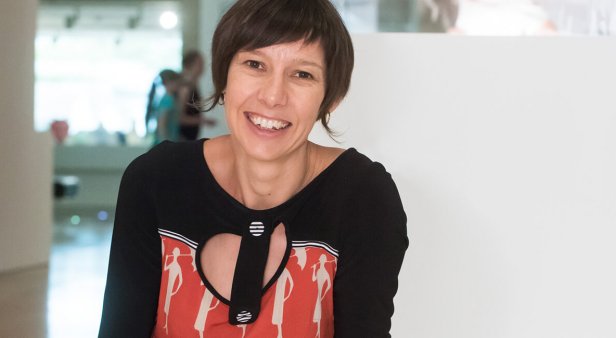What can you remember of your first experience with Papua New Guinean art?
It was 4:30 am in the morning and I was standing on the beach just outside of Kokopo in East New Britain, seeing the black outline of Tolai Tubuan on a small dingy, etched against the blue sky and puffing nearby volcanoes. I can remember the sounds of people singing all around, the blanketing warmth, the smell and the incredible leaf covered forms of the Tubuan as they moved in fluid gyrations.
Queensland Art Gallery recently welcomed No.1 Neighbour: Art from Papua New Guinea 1966–2016 into a number of its spaces. What can you tell us about the concept behind the exhibition?
The exhibition celebrates the vibrancy and diversity of contemporary art in Papua New Guinea. It also seeks to engage audiences in the shared history between our two countries.
How did you approach the task of bringing together a cross-section of work that accurately reflects the history and style of Papua New Guinean art?
The exhibition was never intended as a comprehensive survey of contemporary art from Papua New Guinea. Building from works in our collection I sought to tell stories that expanded understandings of Papua New Guinea, its cultures and our shared history.
In your opinion, what are some characteristics of Papua New Guinean art that make it striking and unique?
There are over 800 living languages in Papua New Guinea, so what is striking is the diversity. There is also a sophisticated understanding of the pattern, colour and form and technologies for capturing attention.
The exhibition takes in decades of artistic expression and growth – how has the country’s modernisation and development affected the way art is made in Papua New Guinea?
Processes of modernisation have seen the experimentation with different materials and techniques as well as an engagement with new issues and ideas. Some of these result from increasing urbanisation, changing lifestyles and values, but also through conversations taking place on global platforms.
Is there a particular work that you think is a must-see piece in the exhibition?
I recommend taking the time to see the immersive a Bit na Ta installation we commissioned for the exhibition, working with Wantok Musik Foundation. The installation brings together a rich interweave of new recordings of singsing tumbuna (ceremonial song), string band, lotu choir style and contemporary soundscapes along with new videos and archival footage to tell the story of the enormous changes that have washed over the century 1875-1975 in Rabaul, from the perspective of the Tolai peoples who inhabit this bay area in East New Britain.
No.1 Neighbour: Art from Papua New Guinea 1966–2016 also features a range of public programs and had a range of series events at the opening – what can you tell us about those?
Visitors to the opening weekend were able to join artists talks, cooking demonstrations and hear performances of songs in the a Bit na Ta installation by the celebrated Tolai musician and songwriter, George Telek and Australia’s own David Bridie. There was also a wonderful performance of Florence Jaukae Kamel’s bilum wear by local production company Sunameke, while a range of artist and curator talks will close the show.
What do you hope visitors take away from experiencing the exhibition?
An expanded view of Papua New Guinea and a curiosity to know more!
What are some words of wisdom that you live by?
Rumi: “Let yourself be silently drawn by the stronger pull of what you really love.”
No.1 Neighbour: Art from Papua New Guinea 1966–2016 will be exhibited at Queensland Art Gallery until Sunday January 29.
